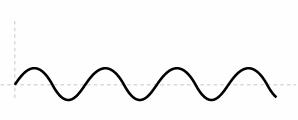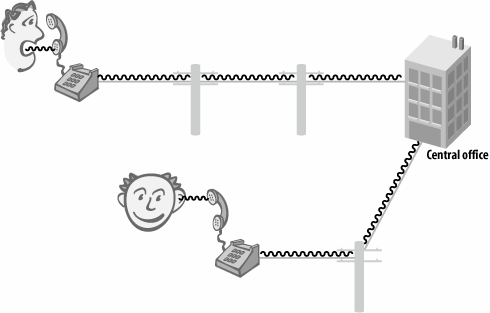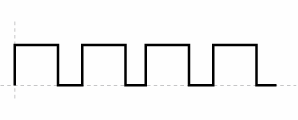Section 1.1. Analog to Digital, Voice to Data
1.1. Analog to Digital, Voice to DataAnalog means many things to different technical disciplines, but to me it means real life. Nature is analog; numbers are digital. We speak in analog, because sound waves are continuously fluctuating and naturally created. Remember the graph of a sine wave you saw in school? Figure 1-1 shows how the sine wave looked then, and still looks today. Figure 1-1. Your basic sine wave Notice the wave form is smooth and continuously variable, such as what you get from a pure tone. You can illustrate the natural and continuous nature of analog yourself by singing a note and then sliding up and down through notes rather than changing from one note to another like a scale (you have my permission to wait until you're alone). Note: Analogies AboundTech factoid with literary hook: An analog device is analogous to the real world it represents, such as the hands sweeping over a round clock face representing the rotation of the globe (English teachers love analogies). Telephone systems, starting with the first one built by Alexander Graham Bell up to the ones built a few decades ago, connected the speaker and receiver with copper wires. A diaphragm (microphone) in the receiver moved as sounds hit it, creating an electrical current. At the speaker, the electrical signals moved the speaker material to recreate the sound waves for the listener. Figure 1-2 shows a simplified telephone network connection. Things are a bit more complicated, of course, but Figure 1-2 shows the analog world of early telephone usage. Every phone was physically connected to a telephone company central office, where all the switches connected your phone to the phone you called. There are central offices everywhere because they needed to be relatively close to the telephone at each end of the line. Figure 1-2. The analog world of telephony If you're old enough, you may remember that long distance calls were scratchy, noisy, and difficult to hear. That's because amplifying (electrically boosting) the signal for long distances across multiple central offices always introduced noise into the circuit and degraded the quality of the sound. If you don't remember long distance calls being of poor quality, then you didn't make any of those calls until the telephone company (AT&T) upgraded their systems and replaced copper wires for long connections with microwave, satellite, and fiber links. It's been decades since a long distance phone call spent the bulk of its journey over only physical wires. Parts of your conversation that go over fiber cables, satellite links, and the like are digitized inside the telephone network and converted back to analog signals before reaching the other end. But the circuit for each voice call remains open, with all the bandwidth (some portion of the telephone carrier's overall capacity for calls and data, which is, unfortunately, a finite resource) in use that's needed for both people to talk at once, even though most of the time there's only silence on the line (between words, and of course the listener is silent while listening). All that silence wastes bandwidth, but the traditional phone call requires that enough bandwidth for both parties to talk at once be reservedafter all, if your phone didn't make it possible to have long distance shouting matches, what good is it? 1.1.1. Moving from Analog to DigitalOne of the many reasons the world is moving from analog to digital is that signal degradation problem mentioned in the previous paragraph. Each time a new technology comes out that provides higher resolution digital products, the quality improves over the analog version used previously (remember how much better CDs sounded than cassette tapes?). Notice that requirement for "high resolution" in digital products. Early digital products were considerably worse than their analog counterparts (for example, digital cameras have only recently caught up with the quality of traditional film). Figure 1-3 shows the sound wave in the sine wave shape from Figure 1-1 converted into a basic, low resolution digital form. Figure 1-3. A basic digital signal When I say basic, I mean basic. Digital information, popularly represented as 1s and 0s, really represents just on and off. That's iton and off. Nothing in the digital world gets more basic than on or off, and that's the foundation of all digital technology. A digital phone conversation at this resolution level hurts your ears (silence, beep, silence, beep etc.speed it up and you've got the sounds of a dial-up modem, which is an analog representation of a digital signal). The digital representation of the sine wave in Figure 1-3 changes only state (moves from off to on to off to on) at the top and bottom of the sine wave signal. You either have silence or a beep. As digital resolution improved, sound waves were measured more frequently. Now sounds are measured thousands of times per second (44,100 by standard Internet Telephony devices), and even millions of times per second in laboratory settings. Voice quality is no longer an issue, assuming there is enough bandwidth for the conversation. One of the biggest advantages for digital over analog information is the ability to copy digital information exactly. Not copy information closely, but exactly.
A quick example? Let's say you write a joke (or steal it from the Internet and hope no one notices), print it out, and give it to two friends. Those friends Xerox that joke (excuse me for making that trademark a verb, they make a xerographic copy) and give it to two more friends. Those two copy their pages, and so on. After a while, the fifth-generation copies will be fuzzy and possibly difficult to read. But a copy printed out of your word processor will be just as clear as your original. Note: Ancient HistoryI wanted to use cassette tapes as the example, but my two teenagers weren't sure what cassettes were or why anyone would copy one. Analog telephone conversations degrade when interference gets into the circuit anywhere along the line. Digital telephone conversations do not degrade, no matter how many switches they go through, because a digital message resists that interference. In fact, most switches clean up the messages by ensuring the timing spaces between bits remain uniform and signal levels remain correct. Digital telephone conversations do have problems at times, but their problems are different. In fact, the problems are much more advanced and sophisticated and come from different areas than interference and noise in analog circuits. Luckily, digital telephone problems are rarer than analog telephone problems by a wide margin. 1.1.2. Analog to Digital ExamplesExamples like these are good for parents or bosses who resist technology. Perhaps one of the examples will hit a soft spot and your technology resister will see that you're trying to help them with a Broadband Phone. With luck, they will then give you either a hug or a raise, depending. Not every digital product has eliminated their corresponding analog ancestor, but new sales volume leans strongly toward the digital and away from the analog. And even in areas where that sales volume has yet to favor digital, digital products have the momentum, as shown in Table 1-1.
This table doesn't proclaim that every digital technology automatically renders the earlier analog technology obsolete and useless. Personally, I prefer clocks with hands that show the sweep and continuation of time, but that philosophical argument annoys my teenagers. Until recently, the resolution of film in cameras was higher than that of digital, but in the most popular size, 35mm, digital cameras now have more resolution than the film cameras they replace. That is not yet true for larger film formats. See, digital phone conversations are a natural evolution as digital technology develops to the point that it can equal and even improve upon analog phone conversations. While some of the phone technology and business models in Internet Telephony can rightly be called revolutionary, the idea that telephones would go digital is an evolution of society's constant improvement. |
EAN: 2147483647
Pages: 102